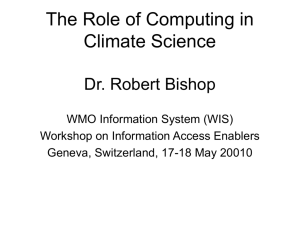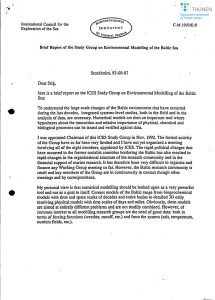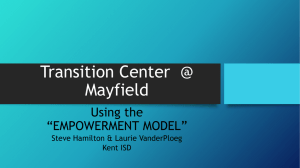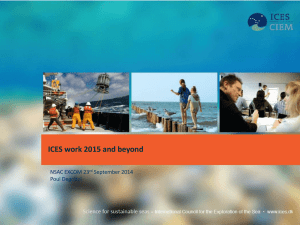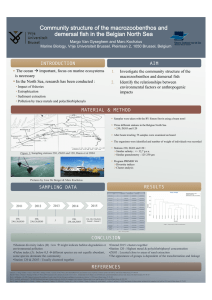ICES WGCHAIRS REPORT 2011
advertisement
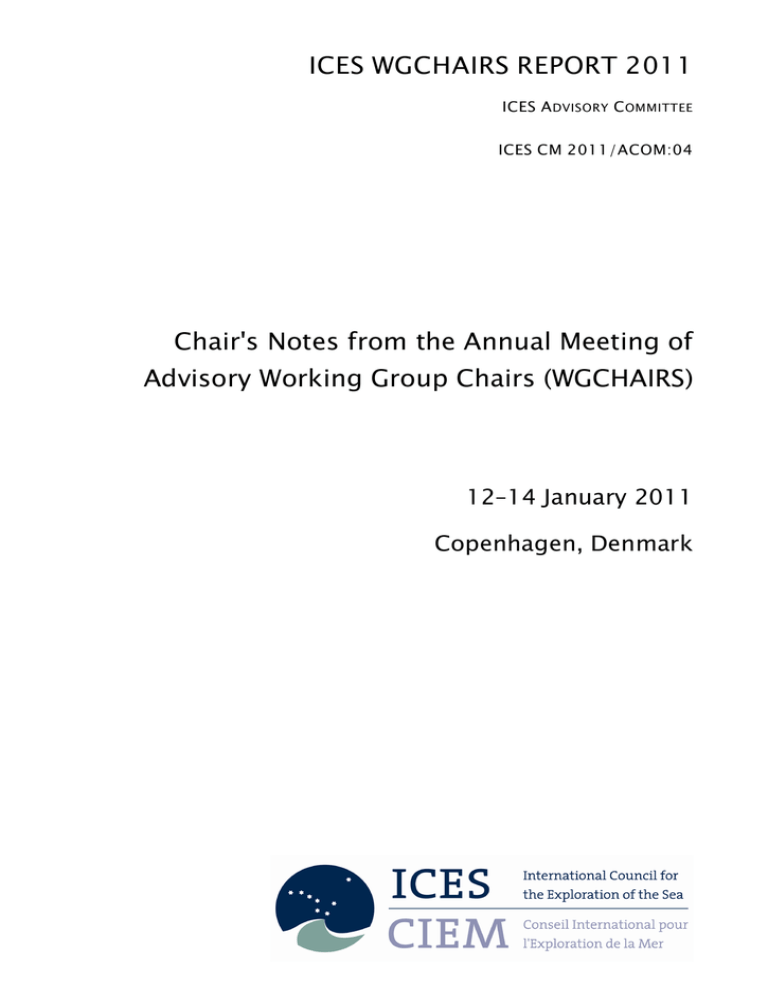
ICES WGCHAIRS REPORT 2011 ICES A DVISORY C OMMITTEE ICES CM 2011/ACOM:04 Chair's Notes from the Annual Meeting of Advisory Working Group Chairs (WGCHAIRS) 12–14 January 2011 Copenhagen, Denmark International Council for the Exploration of the Sea Conseil International pour l’Exploration de la Mer H. C. Andersens Boulevard 44–46 DK-1553 Copenhagen V Denmark Telephone (+45) 33 38 67 00 Telefax (+45) 33 93 42 15 www.ices.dk info@ices.dk Recommended format for purposes of citation: ICES. 2011. Chair's Notes from the Annual Meeting of Advisory Working Group Chairs (WGCHAIRS), 12–14 January 2011, Copenhagen, Denmark. ICES CM 2011/ACOM:04. 18 pp. For permission to reproduce material from this publication, please apply to the General Secretary. The document is a report of an Expert Group under the auspices of the International Council for the Exploration of the Sea and does not necessarily represent the views of the Council. © 2011 International Council for the Exploration of the Sea ICES WGCHAIRS REPORT 2011 | i C o nten ts Introduction ............................................................................................................................. 1 1 Review the Table of Contents for the ICES Advisory Report for 2011 and for each chapter identify what the groups shall contribute ........................... 1 2 Guidelines to EGs regarding how to prepare Recommendations ........................ 1 3 Archiving working papers that are necessary to support an expert group meeting report .................................................................................................... 2 4 Review activities on follow up to the Marine Strategy Framework Directive .......................................................................................................................... 2 5 Review Baltic commitment on an Integrated Ecosystem Observation System .............................................................................................................................. 2 6 The implementation of including ecosystem drivers generic considerations in the fisheries advice – including how the use of ecosystem overviews can be encouraged and how they may be changed to be better reflected in advice .................................................................... 3 7 Discuss benchmark progress: results from earlier benchmarks, preparation process for future benchmarks in or outside of the EGs .................. 4 8 Review the results of strategic initiatives (biodiversity and marine spatial planning) ............................................................................................................ 4 9 Discuss the implementation of long-term management simulations and evaluations of recovery plans and harvest control rules (ICES methodology so far, planning for improvement of evaluation strategy) ............ 5 10 Review the links between assessment working groups and the PGCCDBS on the coordination and prioritization of data collecting.................. 5 11 Review the Table of Contents of WG reports in 2011 ............................................. 6 12 Joint session with WKFRAME2 planning the implementation or updating of precautionary reference points and (new or provisional) MSY reference points .................................................................................................... 7 13 Benchmarks in 2011 and 2012 ...................................................................................... 7 14 Review developments in strategic initiative on stock assessment methodology (SISAM) in relation to the implementation in the Assessment Working Groups ...................................................................................... 7 15 Review results of WGMIXFISH (September 2010 meeting) and discuss recommendations for guidelines to achieve consistency in short-term forecast methodology between stocks. To result in plans for extension of areas for which ICES can give mixed fisheries advice ....................................... 8 ii | ICES WGCHAIRS REPORT 2011 16 Format of the advice: Report back from ACOM and client meetings. This includes specifically discussion of the state of stock tables ......................... 8 17 Fishing technology integration with stock assessments. The use of WGFTFB in stock assessments and advice ............................................................... 9 18 AOB .................................................................................................................................. 9 19 Chair’ summary of meeting conclusions ................................................................. 10 20 Closure ........................................................................................................................... 10 Annex 1: List of participants ................................................................................ 11 ICES WGCHAIRS REPORT 2011 | 1 Introduction The meeting was opened at 9h00 on January 14, 2010. The chair welcomed participants and asked them to introduce themselves. He thanked Mike Sissenwine, the previous chair of ACOM, for agreeing to participate in this meeting to facilitate the transition. No other items were added to the agenda. 1 Review the Table of Contents for the ICES Advisory Report for 2011 and for each chapter identify what the groups shall contribute This agenda item was introduced by Poul Degnbol from the Secretariat. The table of content for the 2011 Advisory Report by eco-region is based on the 2010 ToC updated with expected requests for advice, new stocks in the Memorandum of Understanding with the European Commission, the addition of indicator overviews overall and on a regional basis. The MSY section will probably be revised based on the results of WKFRAME2 and the experience in formulating the 2011 advice. New MOU species were assigned to specific Expert Groups rather than WGNEW. Boarfish was assigned to two groups but should probably go to WGWIDE, probably a single stock straddling two eco-regions and the methods are likely similar. Several new stocks were assigned to WGHMM and it is not clear that the Working Group will be able to make progress on these. It has to be discussed with Chairs to decide where the stocks will be handled as well as what will be done where and when. Some stocks may have to go through WGNEW before going to individual Expert Groups. Catch and effort data might be available for all new species, but biological data may not. Participants understood that full fledge analytical assessments are not necessarily expected for these new species. The Advisory Workplan (to be found at http://groupnet.ices.dk/Advice2011/Documents/Forms/AllItems.aspx) was introduced. This is a living document that should be consulted regularly and not all dates have been set or reviewers / advice drafters identified. 2 Guidelines to EGs regarding how to prepare Recommendations The ICES policy is that ACOM is the body providing advice for management. EG reports often contain text that can be misinterpreted as ICES advice. This should be avoided. Guidelines have been provided on drafting recommendations and chairs are encouraged to follow them. These guidelines are included in the Chairs Handbook (http://www.ices.dk/workinggroups/Guidelines%20for%20Chairs%20of%20ICES%20 Expert%20Groups_Nov2010.pdf). ICES advice is provided by ACOM and it is important to minimize the risk of other text being interpreted as ICES advice. WGCHAIRS was informed about the development of a new database for Expert Group recommendations. The new database will be filled out by the secretariat in 2011. But from 2012 recommendations should be entered into the database by the Expert Groups. 2 | 3 ICES WGCHAIRS REPORT 2011 Archiving working papers that are necessary to support an expert group meeting report This agenda item was introduced by Poul Degnbol based on Doc 10a from the November 2010 ACOM meeting. Presently it may happen that a working paper presented to a working group is used as a basis for the analysis and ultimately for the advice, but the working paper is not publicly available subsequently. This is in contradiction with the basic policy of transparency which ICES has committed to. It is therefore necessary to establish a system which ensures that any documentation forming the basis for the final advice can be retrieved. To this end ACOM has decided (Doc 10a ACOM 2010) that working papers that have been used in the formulation of advice must be available for documentation purposes and for those wishing to repeat the analyses by one of the following options: a ) Fully documented in the EG report (that is, the substance of the working paper is integrated into the EG report); b ) Included as an authored annex to the EG report; or c ) A link will be provided in the EG report to a site where the information can be accessed – this will typically be the case if the authors are preparing submission to a journal and do not want pre-publication as an annex to the EG report. Background documents prepared for ACOM outside EG groups to answer special requests will be documented in a new series of Documents in Support of ACOM Advice. The above will be included in the ACOM EG chairs handbook. 4 Review activities on follow up to the Marine Strategy Framework Directive Eugene Nixon introduced this agenda item. ICES has set up an ACOM-SCICOM Steering Group to ensure that ICES makes it fullest contribution. The Steering group is expected to prepare a glossy document of what ICES could do in implementing the MSFD – and this may be seen as helpful and might be picked up by someone. For fisheries data, all parameters have been agreed the information fits directly in the MSFD. There is scope in the MSFD for considerable duplication and for gaps to be missed. ICES can play a role in avoiding duplication and in helping filling gaps. The collection of fisheries data already fits well and is consistent with the MSFD. Habitat descriptions are also covered. Every EG should have a small discussion to identify what information it can contribute. EG Chairs were encouraged to contact the Steering Groups if issues were identified by the group. Most important is to highlight ICES work. It is a new way of working (wake-up call); we have to broaden our minds. Chairs should them self think about how their material can be used. Eugene will prepare half a page summary to be circulated to chairs. 5 Review Baltic commitment on an Integrated Ecosystem Observation System This agenda item was introduced by Mike Sissenwine. The ICES Baltic Sea Commitment was made in 2010. The next steps are under review by the Bureau and the ICES WGCHAIRS REPORT 2011 | 3 Council. The ACOM-SCICOM MSFD Steering Group, possibly with the addition of a SCICOM Vice-Chair, will coordinate ICES involvement on this. ICES prominent role in supporting the EC in the DCF is a real tangible asset to try to make the system work. The glossy document to be prepared by the ACOM-SCICOM Steering Group on the MSFD should be helpful here as well. The Baltic Commitment presents important opportunities to justify the support for existing surveys and monitoring. It is also an opportunity to encourage the development of improved observing system technology and infrastructure and it might influence the 2013 revision of the EC Data Collection Framework and perhaps plant the seed for an MSFD Data Collection Framework. It is now time to engage the scientific community (e.g. by briefing WGIAB and WGBFAS), assemble background information in addition to the report ‘Integrated monitoring and assessment of the Baltic Sea’ written by Chris Hopkins in 2010 and outreach to potential partners (HELCOM – necessary partner), users and stakeholders. It is also time to brief Brussels on the relevance to CFP, DCF, MSFD. A broad based open workshop could be organized in 2011 to give a chance to people to contribute. EG could consider the usefulness of integrated observing systems and how to do it. There is a broad range of opportunities. There is potential synergy between fisheries work and the MSFD, ICES has knowledge and processes that can be very useful if properly made available and used. Gerd Hubold reported from HELCOM meeting. HELCOM might not ask ICES for formal advice but there are at least five important areas where HELCOM suggests close cooperation with ICES. We should identify the ICES capacities in the Expert Groups. The ACOM-SCICOM MSFD Steering Group could be a focal point. 6 The implementation of including ecosystem drivers generic considerations in the fisheries advice – including how the use of ecosystem overviews can be encouraged and how they may be changed to be better reflected in advice This agenda item was introduced by Poul Degnbol. Progress has been made towards incorporating ecosystem drivers in ICES work e.g. through the integrated assessments EGs, and regional seas initiatives but it remains necessary to find out how to incorporate in advice including the fish stock advice. The MSY framework may counteract this with its present focus on single stocks but has also made an understanding of ecosystem drivers even more pertinent since this also requires understanding of what drives ecosystem productivity. However, there are more people working on increasing ecosystem knowledge than people working on how to use this knowledge in providing advice. As long as the user of the advice manages fisheries on a single species basis, the incentives are not there. Multispecies and integrated advice is requested in non-traditional fisheries management fora, such as marine spatial planning. Working at a finer spatial resolution might make help in this regard, but the heavy workload in Expert Groups remains a problem. It is not straightforward to include ecosystem drivers into advice as few cause and effect relationship have withstood the test of time. A practical suggestion would be to share expertise (people) between EGs. The benchmarking process could also be a way to speed up the process of providing integrated advice but unless a special effort is being made the same people attending the EGs will attend the benchmarks. Benchmarks meetings should be attended also by ecologists, but we need to plan for if we want it to happen. Steer- 4 | ICES WGCHAIRS REPORT 2011 ing Group on Regional Sea Programmes can carry on the work from WGRED but a way to share work with ACOM Expert Groups need to be identified. ICES / ACOM should keep pushing forward and we will find ways to use integrated advice. The Council is particularly keen on finding practical methods to account for climate change. Participation in Expert Groups of people who can contribute to this aspect remains problematic. Decreasing the frequency of assessments could free up time to work on these issues. 7 Discuss benchmark progress: results from earlier benchmarks, preparation process for future benchmarks in or outside of the EGs This agenda item was introduced by Barbara Schoute. EG chairs agreed that the benchmarking process was an appropriate forum to introduce multispecies or integrated assessments, but insisted on the need to make it clear from the outset what the purpose of the benchmark assessment would be: improve on the technical basis of the assessment or move the assessment into a completely different integrated framework. Whatever the case may be, finding qualified outside reviewers will remain a challenge. In this context, it is important not only to get the ToRs correct, but also the name of the group because it does have an influence on attendance. EGs should have some flexibility to change the settings from the benchmark process when needed. It was highlighted that stakeholders are participating in the Benchmark workshops and that this is valuable for both scientists and stakeholders. The secretariat asked WGCHAIRS for ideas on how to get the methodological groups involved. We might have to manage the process more closely and approach the needed experts. It needs to be made clear when work is to be done for benchmarks. People have very different views on the process. Perhaps better ToRs. Key issue is to adjust agenda, perhaps to a less number of stocks. 8 Review the results of strategic initiatives (biodiversity and marine spatial planning) This agenda item was introduced by Eugene Nixon. On marine spatial planning, Eugene Nixon and Erik Olsen had drafted a communication to chairs for all SCICOM and ACOM EGs to provide information on the strategic initiatives on biodiversity and marine spatial planning. A questionnaire was sent to EG chairs, and 28 replies were received. This would be a first step in identifying what information is available and EG chairs are encouraged to complete the questionnaire. With a little extra work, ICES could be the primary provider of data for marine and coastal spatial planning. Information potentially useful in this regard could be found in stock annexes. On the biodiversity strategic initiative the objectives are to: 1 ) Ensure that ICES develops and promotes a niche that links marine biodiversity science and advice. 2 ) Positioning of ICES to ensure that it is regarded as an effective and reliable source of biodiversity advice in the ICES Area, with relevance to wider seas. ICES WGCHAIRS REPORT 2011 | 5 3 ) Ensure that ICES understands its customer’s needs and can link effectively with partners and others holding biodiversity information. 4 ) Catalyse new research on marine biodiversity that increases profile and relevance of ICES. 5 ) Improve the capacity of ICES to provide rigorous, consistent and legitimate advice relating to biodiversity. 6 ) Ensure that ICES is proactive in identifying science and advisory needs relating to biodiversity through monitoring policy development and coordinating its expert groups. The Workshop on Marine Biodiversity, 9–11 February 2011, is intended to be the start of a process to increase the visibility of ICES in biodiversity science and advice, to reduce duplication of work and to increase efficiency of monitoring, assessment and reporting on marine biodiversity issues. 9 Discuss the implementation of long-term management simula- tions and evaluations of recovery plans and harvest control rules (ICES methodology so far, planning for improvement of evaluation strategy) This agenda item was introduced by Manuela Azevedo. Formal management strategy evaluation or evaluations of management plans should be done outside of assessment EG’s in special EGs set up specifically for that purpose. STECF has developed guidelines on how to evaluate management plans and ICES will work with STECF to evaluate five cod management plans in 2011. An evaluation of the ability to achieve biomass, F and catch targets is relatively simple with FLR, but the evaluation becomes more complicated when more factors have to be taken into account. 10 Review the links between assessment working groups and the PGCCDBS on the coordination and prioritization of data collecting The InterCatch portion of this agenda item was introduced by Henrik Kjems-Nielsen. The use of InterCatch is increasing. All participants are aware of the importance of documenting what has been done and of having the ability to reproduce what has been done. Code (Common Open Source Tool - COST) has been developed in the DCF to make it easier to export data to InterCatch (Alternatively a conversion tool has been created (spreadsheet to InterCatch). No real argument for not converting data). For some EG, InterCatch is of no use, but the information that can be found in InterCatch should be available for all EGs. Lack of time explains why InterCatch has not been used more in some EGs. Views differed on whether to fill gaps nationally or leave them visible to a later stage. In all cases, documenting what has been done is of primary importance to know how gaps have been filled. InterCatch lacks flexibility, e.g. when there are two stocks in the same area. In the DCF EU members must supply data within 20 days if someone asks for it. In the Baltic, countries agreed to use FishFrame and they have started uploading 2010 data. In the North Sea and in the North Atlantic, countries have also agreed to use regional data bases. In the future it will be very easy to upload data into InterCatch. 6 | ICES WGCHAIRS REPORT 2011 Using InterCatch may also be a capacity issue. Uploading data can be difficult in the beginning and the training is useful. Chairs were asked to encourage stock coordinators to attend the InterCatch Workshop in February. It was mentioned that the WGDEEP had asked for a specific Workshop prior to the WGDEEP meeting. The Planning Group on Commercial Catches, Discards and Biological Sampling (PGCCDBS) portion of this agenda item was introduced by Christoph Stransky. It is important that EGs do include the PGCCDBS table in the report if they have data issues that they want the PG to examine. It is important for ICES to close the loop with the PG, i.e. the recommendations from the PG should be considered by the EGs and implemented, but this may have to wait a benchmark assessment. ICES could also forward PGCCDBS recommendations to clients and member states. It is also useful if EGs indicate not only what data they need, but also what data they are unlikely to use (e.g. age data for grenadiers). The PGCCDBS was asked to advise on the best way to incorporate newly collected maturity data into assessment as the introduction of new data can create more variability if sampling for maturity was not appropriate. PGCCDBS asked that the score card to detect bias in sampling be used by EGs and that ICES mentions to clients the importance of having appropriate experts in PGCCDBS groups. PGCCDBS was asked to consider the best way to present sampling intensity information in EG reports and to advise on minimum and target sampling intensity for collecting biological information. Chairs were reminded that data are the bread and butter of ICES’ work. Stock ID reviews by PGCCDBS are dealt with at benchmark assessments; it is not possible to include this information in update assessments. It may not be necessary to collect otolith information for all species with the purpose of calculating quarterly (or finer) catch at age. For some species / stocks the purpose of collecting otholiths may be to periodically update a growth curve. The review of the DCF may provide guidance on the collection of age information and usage of age–length keys (ALKs). But it is important to maintain, and share, the expertise in terms of age determination. Participants were informed that the North Sea and North Western Regional Advisory Councils have requested a meeting with ICES (including relevant chairs) to investigate ways to improve assessments and the ability to provide management advice. Participants encouraged initiatives to improve the contribution of the industry to improve data available for assessments. 11 Review the Table of Contents of WG reports in 2011 Cristina Morgado introduced this agenda item. The table of content of assessment EG report was briefly discussed. The ICES secretariat was asked to confirm with the EC that maturity and gender ratio should not be asked for landings (as it is not possible to estimate from gutted fish) and discards (as it is not normally done). The table should be completed with tick marks when data were available and used. PGCCDBS was asked to provide guidelines on the best means to document sampling intensity and to provide guidelines on target biological sampling rates. EGs should be careful when indicating that data were available but have not been used. This may imply that data that will be useful may cease to be collected. Some chairs were of the opinion that the datatable was too simplified and a policing tool, which should be reconsidered. ICES WGCHAIRS REPORT 2011 12 | 7 Joint session with WKFRAME2 planning the implementation or updating of precautionary reference points and (new or provisional) MSY reference points This agenda item was introduced by Ciaran Kelly, Chair of WKFRAME2. The importance of having appropriate pa reference points was stressed. The framework to provide advice in 2011 will be similar to 2010 and hopefully improved. WKFRAME2 will make options available and a policy decision will be made by ACOM. It is important to maintain consistency and clearly explain changes to avoid confusing the users of ICES advice. Examples of possibly problematic situations (what to do when the F decrease is estimated to be larger than what was advised) were discussed and these will have to be resolved when ACOM provides advice later in the year. In this context, advising on a fishing mortality to rebuild above Btrigger over a pre-specified number of years could be considered. Options will continue to be available in the forecast table, but possibly not on the first page as this has created confusion in 2010. In 2010, Bpa was generally used as a first estimate of Btrigger until more information is available on the biomasses generated when fishing around FMSY. When sufficient information has been collected, Btrigger will be revised. The MSY framework is an extension of the PA framework and the two complete one another depending on stock and fishery status. WKFRAME2 will be suggesting that discontinuities be avoided. 13 Benchmarks in 2011 and 2012 Barbara Schoute introduced this agenda item. Benchmarks planned for 2011 and 2012 were listed. Eel pout in the North Sea will be added to the list and further discussion on the process for deep-water fisheries in the Celtic Sea is necessary. It is also important to ensure that the benchmark group has the expertise to review the assessment method used (e.g. GADGET for tusk). The Secretariat will prepare a description of the process to choose benchmark species. This will be distributed to Chairs for their comment and input. ToRs and list of participants will make it clear whether the benchmark aims at improving the assessment, or at providing an entirely new integrated assessment. Given the difficulty of securing the participation of outside observers, if funds available, it would be using them well to pay for outside reviewers. It is a positive feature that assessments accepted by a benchmark was later rejected by the EG and that one rejected by the benchmark was later accepted by the advice drafting group. This means that Expert Group members are paying attention. It is important to ensure that benchmark workshop have the expertise to review all the methods used in the benchmark assessment. The Secretariat will prepare a description of the benchmark process. Chairs were asked to forewarn ACOM when the basis for advice changes (e.g. if an assessment method approved by a benchmark but rejected by an EG is accepted by the EG). 14 Review developments in strategic initiative on stock assessment methodology (SISAM) in relation to the implementation in the Assessment Working Groups Carmen Fernandez introduced this agenda item. The strategic Initiative on stock assessment methodology (SISAM) is intended to identify best practices worldwide in 8 | ICES WGCHAIRS REPORT 2011 single species assessments and implement them in ICES. The North Atlantic is special in having complete catch-at-age information for many species, but there are also a large number of stock/species where age information is insufficient to provide advice using ICES’ traditional assessment methods. It is important that SISAM be able to fully compare the results of the various assessment methods, that the work focuses on diagnostics, and that the usefulness of the assessment method in an advisory context will be considered. In this context, SISAM should consider how to provide advice in a data poor context. The workshop planned for 2011 on ICES stocks could cover both good and problematic assessments. SISAM could provide test datasets and provide advice on the pros and cons of assessment toolboxes in the broad context of quality assurance. A useful product could be a decision tree of available data / information and appropriate assessment method. As the next step, ICES also has to find a way to get this knowledge into the EGs. It is important to have experts who can evaluate the models and identify the most appropriate choice for each case in an EG. 15 Review results of WGMIXFISH (September 2010 meeting) and discuss recommendations for guidelines to achieve consistency in short-term forecast methodology between stocks. To result in plans for extension of areas for which ICES can give mixed fisheries advice This agenda item was introduced by Steven Holmes, the chair of the WGMIXFISH. The max scenario assumes that all TACs for all métiers will be reached – this is a highly optimistic scenario as there are always some allocations that stay in the water. The work of WGMIXFISH is based on the Fcube methodology. Considerable efforts have been made to distribute and increase usage, but uptake has been limited. It would be useful to extend to other areas if only to compile the necessary data to better understand the fishery to summarize who is fishing what, when and where. The Fcube method does not necessarily require an analytical assessment – it has been used in the Mediterranean for stocks with Y/R results. It does require catch and effort information, but not by age. This raises the issue of availability of discards data as landings still have to be used instead of catches for some stocks. Management options in WGMIXFISH should be linked to the MSY framework and the decisions made by ACOM following WKFRAME2. ACOM is expected to provide mixed fishery advice to the EC in the near future even though TACs may not be set using mixed fishery advice. The main objective in the next two years would be to enter in discussion with policy makers to figure out how to implement mixed fisheries advice in the future. A meeting with policy makers could be arranged to advance the process. 16 Format of the advice: Report back from ACOM and client meetings. This includes specifically discussion of the state of stock tables This agenda item was introduced by Barbara Schoute. There remains a few useless “levels” in the format of advice – hopefully it will be possible to remove them. The upside or downside question mark remains problematic – if a symbol needs a long explanation, it is not a good symbol. Perhaps having one or two question marks ICES WGCHAIRS REPORT 2011 | 9 could be used for cases where either stock status is not determined or reference points have not been set. There are also cases where entries are not relevant (e.g. F for capelin is not an issue). Advice list: In the future advice will only be given according to the management plan if one management plan is agreed as the basis of advice by all partners. State of stock table. Clients wish ICES to be explicit on the state of the stock. Future table will include colours and signs. Aim is to have stock status in one view. New column for qualitative evaluation. Survey acronyms are being standardised this year. List to be circulated before the first Expert Group meeting. 17 Fishing technology integration with stock assessments. The use of WGFTFB in stock assessments and advice This agenda item was introduced by J.-J. Maguire. The information provided by the WGFTFB is used by several EGs and they find that the information is very useful. Even though the information is often qualitative rather than quantitative, it does put observations and results in context and helps in interpreting them. Not all EG chairs were aware of the information and greater usage can be expected in the future. This should definitely be continued. The WGFTFB should be congratulated on their excellent work and thanked for it. In order to be fully useful, the WGFTFB report should be made available early in the year. This information should be brought to the attention of EGs. It was suggested that WGFTFB should make recommendations directly to individual Expert Groups whenever it sees this as the most relevant route. 18 AOB There was no other business. WGCHAIRS was informed that ICES and EC are close to finishing the new MoU. Main issue is the stock list. 10 | 19 ICES WGCHAIRS REPORT 2011 Chair’ summary of meeting conclusions The chair provided a brief summary of meeting conclusions. This was put on the SharePoint. 20 Closure The meeting was closed at 11h00 on January 14. The Chair thanked the participants for a very informative meeting. “Safe travel home. Look forward to see you in the near future”. ICES WGCHAIRS REPORT 2011 Annex 1: | 11 List of participants Name Jean-Jacques Maguire ACOM Chair Address Email 1450 Godefroy JJ.Maguire@ices.dk Sillery Quebec GIT 2E4 (Chair) Canada Phone +1 418 688 5501 Fax +1 418 688 7924 Manuela Azevedo ACOM ViceChair IPIMAR manuela@ices.dk Avenida de Brasilia PT-1449-006 Lisbon Portugal Phone +351 213 02 7148 Fax +351 213 025948 Ewen D. Bell WGNSSK Centre for Environment, Fisheries and Aquaculture Science (CEFAS) Lowestoft Laboratory ewen.bell@cefas.co.uk Pakefield Road NR33 0HT Lowestoft Suffolk United Kingdom Phone +44 1 502 524 238 Fax +44 1 502 562 244 Tom Blasdale WGDEEP Joint Nature Conservation Committee Inverdee House tom.blasdale@jncc.gov.uk Baxter Street AB11 9QA Aberdeen United Kingdom Phone +44 1224 655708 Fax +44 1224 621488 Bjarte Bogstad AFWG Institute of Marine Research bjarte.bogstad@imr.no P.O. Box 1870 N-5817 Bergen Norway Phone +47 55 23 86 81 Fax +47 55 23 86 87 Michele Casini WGBFAS Swedish Board of Fisheries Institute of Marine Research, Lysekil michele.casini@fiskeriverket.se P.O. Box 4 SE-453 21 Lysekil Sweden Phone +46 523 18728 Fax +46 523 13977 Maurice Clarke HAWG Marine Institute Rinville Oranmore Co. Galway Ireland Phone +353 91387200 Fax +353 91387201 maurice.clarke@marine.ie 12 | ICES WGCHAIRS REPORT 2011 Name Lotte Worsøe Clausen HAWG Address Email DTU Aqua - National Institute of Aquatic Resources Section for Fisheries Advice law@aqua.dtu.dk Charlottenlund Slot Jægersborg Alle 1 DK-2920 Charlottenlund Denmark Phone +45 21362804 Fax +45 33963333 Jørgen Dalskov Baltic RCM DTU Aqua - National Institute of Aquatic Resources Section for Fisheries Advice jd@aqua.dtu.dk Charlottenlund Slot Jægersborg Alle 1 DK-2920 Charlottenlund Denmark Phone +45 35883380 Fax +45 33 96 33 33 Carmen Fernandez WGHMM Instituto Español de Oceanografía Centro Oceanográfico de Vigo carmen.fernandez@vi.ieo.es P.O. Box 1552 E-36200 Vigo (Pontevedra) Spain Phone +34 986 492111 Fax +34 986 498626 Steven Holmes WGMIXFISH Marine Scotland FRS Marine Laboratory Aberdeen s.holmes@marlab.ac.uk P.O. Box 101 AB11 9DB Aberdeen United Kingdom Phone +44(0) 1224 29 5507 Fax +44(0) 1224 29 5511 Graham Johnston WGEF Marine Institute graham.johnston@marine.ie Rinville Oranmore Co. Galway Ireland Phone +353 91 730490 Phil Large WGDEEP Centre for Environment, Fisheries and Aquaculture Science (CEFAS) Lowestoft Laboratory Pakefield Road NR33 0HT Lowestoft Suffolk United Kingdom Phone +44 1502 562244 Fax +44 1502 513865 phil.large@cefas.co.uk ICES WGCHAIRS REPORT 2011 | 13 Name Tracy McCollin WGBOSV Address Email Marine Scotland FRS Marine Laboratory Aberdeen T.A.McCollin@marlab.ac.uk P.O. Box 101 AB11 9DB Aberdeen United Kingdom Phone +44 1224 295 573 David Miller WGWIDE Wageningen IMARES david.miller@wur.nl P.O. Box 68 1970 AB IJmuiden Netherlands Phone +31 Fax +31 Francis Neat WGDEC Marine Scotland F.Neat@MARLAB.AC.UK P.O. Box 101 AB11 9DB Aberdeen United Kingdom Phone +44 1224 295516 Fax +44 1224 295511 Kjell Nedreaas PGCCDBS Institute of Marine Research kjell.nedreaas@imr.no P.O. Box 1870 Nordne 5817 Bergen Norway Phone +47 55 238671 Fax mobil +47 99 53 85 49 Eugene Nixon ACOM ViceChair Marine Institute Marine Spatial Planning eugene.nixon@ices.dk 80 Harcourt Street Dublin 2 Ireland Phone +353 1 4766538 Fax mob: +353 876 299 677 Henn Ojaveer WGITMO Estonian Marine Institute University of Tartu henn.ojaveer@ut.ee 2a Lootsi EE-80012 Parnu Estonia Phone +372 443 4456 mobile: +372 5158328 Fax +372 6718 900 Erik Olsen SSGHIE Institute of Marine Research erik.olsen@imr.no P.O. Box 1870 Nordne 5817 Bergen Norway Pieter-Jan Schön WGCSE Agri-food and Biosciences Institute (AFBI) 18a Newforge Lane BT9 5PX Belfast United Kingdom Phone +44 28 90255015 Fax +44 28 90255004 pieter-jan.schon@afbini.gov.uk 14 | ICES WGCHAIRS REPORT 2011 Name Mike Sissenwine Former ACOM Chair Address Email Woods Hole Oceanographic Institution M_Sissenwine@surfglobal.net PO Box 2228 Teaticket MA 07536 United States Phone +1 508 566 3144 Christoph Stransky PGCCDBS Johann Heinrich von Thünen-Institute, Institute for Sea Fisheries christoph.stransky@vti.bund.de Palmaille 9 D-22767 Hamburg Germany Phone +49 4038905228 Fax +49 4038905263 Gudmundur Thordarson NWWG Marine Research Institute gudthor@hafro.is Skúlagata 4 IS-121 Reykjavík Iceland Els Torreele North Sea and Eastern Arctic RCM Institute for Agricultural and Fisheries Research (ILVO) els.torreele@ilvo.vlaanderen.be Ankerstraat 1 8400 Oostende Belgium Phone +32 59569833 Clara Ulrich WGNSSK DTU Aqua - National Institute of Aquatic Resources clu@aqua.dtu.dk Jægersborg Allé 1 DK-2920 Charlottenlund Denmark Phone +45 3396 3395 Fax +45 3396 3333 Joël Vigneau WGCSE IFREMER Port-en-Bessin Station joel.vigneau@ifremer.fr P.O. Box 32 F-14520 Port-en-Bessin France Phone +33 231 515 600 Fax +33 231 515 601 Yvonne Walther SSGRSP Swedish Board of Fisheries Institute of Marine Research Utövägen 5 SE-371 37 Karlskrona Sweden Phone +46 455 362 852 yvonne.walther@fiskeriverket.se
